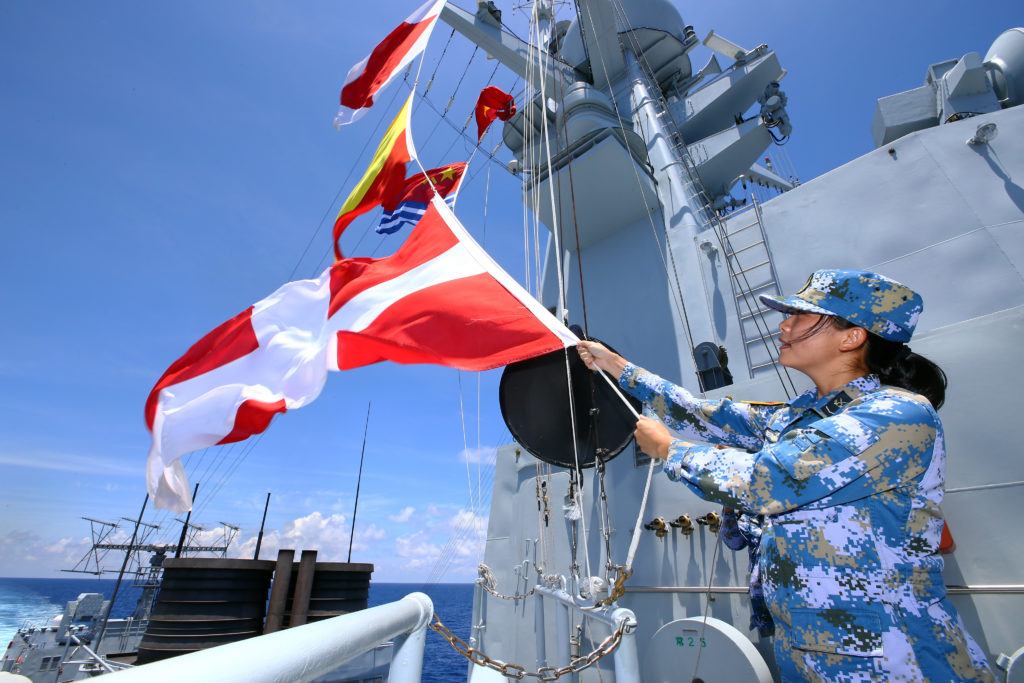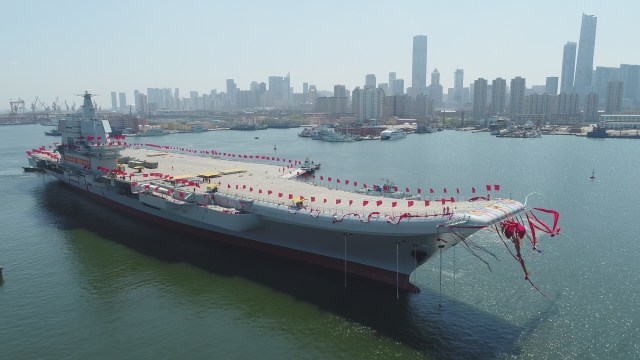China’s first domestically-built carrier is launched, 26 April 2017 (Credit Image: Xinhua/SIPA USA/PA Images)

America’s domination of the Pacific Ocean has been a given since the end of the Second World War. Under the protection of the United States’ nuclear umbrella and its Seventh Fleet, countries such as Japan, South Korea, Taiwan, and the Philippines could develop peacefully and without fear of invasion.
China, however, is steadily aiming to undermine the status quo. Its continuing development of what naval experts call a “blue water navy” threatens to disrupt American dominance of the Pacific, and with that the democratic status of nations that have heretofore depended on American naval power.
Maritime trading nations throughout history have depended upon control of the seas for their wealth and power. Ancient Athens, for example, gained its empire and held off Sparta for over 20 years in the Peloponnesian War because of its naval dominance. It finally lost its power, and the war, when Sparta (with Persian money) created its own navy and defeated the Athenians at the battle of Aegospotami. Britain’s empire was also founded upon its naval power, as any school child who has ever learned about the Armada or gazed upon Nelson’s Column in Trafalgar Square knows.
China is no different. Its wealth depends upon trade, and that trade sails upon ships. It also depends upon the importation of oil and raw materials that also sail on ships. The ability to control those shipping lanes in case of conflict, therefore, is essential to any serious Chinese foreign policy.
That, in turn, requires a “blue water navy”. Naval experts classify naval forces according to the types of waters a country’s force can exert power over. A “brown water navy” can operate within a country’s coastal zones while a “green water navy” can exert power over regional seas close to the coast. A “blue water navy” is one that can successfully project power far from a country’s coast, often thousands of miles from its closest port. Only such fleets can contest the control of open seas and far-away shipping lanes.
China has been openly pursuing this capability for decades. It has steadily built up its navy to the point that its submarines and surface fleet can contest control of the waters between it and Taiwan, making American support of the tiny island in the event of conflict with China more hazardous. But only aircraft carriers can control large ocean spaces. That makes China’s pursuit of such boats extremely important.
China recently launched its second carrier, the first built entirely within the country. Its first, the Liaoning, was launched in 2012, but it was a refitted ship purchased from the Ukraine. Building a carrier domestically allows China to expand its capabilities as quickly as it can learn how to do so.

The People’s Liberation Navy is aggressively pursuing that goal. A senior researcher associated with the Chinese navy, Yin Zhuo, says, “In order to protect China’s territories and overseas interests, China needs two carrier strike groups in the West Pacific Ocean and two in the Indian Ocean. So we need at least five to six aircraft carriers.” To put that in perspective, currently only the United States operates more than two. China’s third carrier, currently under construction, is expected to be much larger and more advanced – and closer to American-quality – than either current ship.
China’s naval buildup extends well beyond aircraft carriers. Last autumn it introduced small ships built with stealth technology. Pictures emerged last month of a new warship that could be outfitted with electromagnetic pulse weaponry, a technology that even the US Navy does not have. It has also launched a new type of modern destroyer that arguably is the most advanced in the world outside of the most modern American designs. The Chinese navy is rapidly expanding its capabilities far beyond those necessary to protect its coastline from invasion.
These trends have not gone unnoticed among China’s regional neighbours. Australia, Japan, India, and the US are exploring joint naval exercises in the South China Sea, a flash point for tensions with China. Japan currently operates two medium-sized “helicopter destroyers” that have many of the capabilities of traditional aircraft carriers. Japanese news media reported last December that discussions with the US are underway that would allow for these ships to carry and launch American-made jet fighters such as the state-of-the-art F-35.
If this is true, Japan would quickly acquire the ability to contest sea lanes independently of the US, giving it greater flexibility in the event of a clash. India launched its first domestically-designed and built aircraft carrier in 2016, with a second, nuclear-powered ship in the planning stages. Even Vietnam is getting into the action, building up its navy with purchases from Russia and hosting a visit from a US carrier group this March.
None of these developments means war is coming soon. But it does show that the backbone of Western defense in the Pacific, the American navy, will come under increasing pressure in the coming years. This in turn can influence other countries which may rethink their alignment with the West.
The Philippines is the great prize in this quiet conflict, as its strategic position astride the north-south sea routes of East Asia means whomever it aligns with has the upper hand in the region. America has long relied on its relationship with the Philippines[1. America governed the Philippines from the conclusion of the Spanish-American War in 1898 until Philippine independence in 1947. Its forces liberated the country from Japanese occupation during the Second World War, and the US maintained air and naval forces in the country for decades until their closure in the early 1990s. Even today the US plans to use Philippine military bases for its operations in the event of confrontation with China.] for its naval strategy in the region, but Philippine President Rodrigo Duterte is moving the country away from its American orientation. The American media often criticises Trump for praising the mercurial and crude Philippine leader, but perhaps the President has been made aware of the nation’s central importance in containing Chinese ambitions and decided that Manila is worth courting.
The world is focused on President Trump’s tweets, but it would be advised to spend a bit more time paying attention to the naval arms race underway in Asia. Capability always precedes conflict, and China’s blue-water naval ambitions will create the possibility for many such conflicts in the years ahead.










Join the discussion
Join like minded readers that support our journalism by becoming a paid subscriber
To join the discussion in the comments, become a paid subscriber.
Join like minded readers that support our journalism, read unlimited articles and enjoy other subscriber-only benefits.
Subscribe